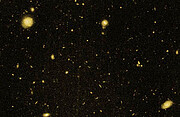A high abundance of massive galaxies 3-6 billion years after the Big Bang
7 July 2004
A Gemini team led by Karl Galzebrook of Johns Hopkins University has just released some spectacular results obtained from the Gemini Deep Deep Survey (GDDS) in the British journal Nature.
The team found that at last two-thirds of massive galaxies appeared after the first 3 billion years following the Big Bang. However, a significant fraction of them are already in place in the early Universe.
The GDDS was completed using the Gemini North telescope and the Gemini Multi-Object Spectrograph (GMOS-N). The team observed four widely-separated 30 arcmin2 fields. The spectroscopic exposure time for each field was about 30,000 seconds. The spectrograph was operated in the Nod & Shuffle mode. This technique enables the removal of contamination by the earth’s atmospheric luminescence to a high degree. Spectra of several hundred distant galaxies were obtained and measured. As has been suspected, massive, evolved galaxies are found at an epoch earlier than half of the present age of the universe. However, the discovery of such massive, evolved galaxies at much greater distances than expected – and hence at earlier times in the history of the universe – is a challenge to our understanding of how galaxies form. Hierarchical galaxy formation is the model whereby massive galaxies form from an assembly of smaller units. The most massive objects form more slowly, thus appear last. The GDDS results challenge this model. The GDDS represent a unique and extremely deep spectroscopic data set providing significant new insights into galaxy populations in the era of a few billion years after the Big Bang.
For more details see the News and views Nature article “Old before their time” by Gregory D. Wirth (Nature, vol. 430, 8 July 2004, pp. 149-150) and the original GDDS III article “A high abundance of massive galaxies 3-6 billion years after the Big Bang” (Nature, vol. 430, 8 July 2004, pp. 181-184). The figures are from this article.




